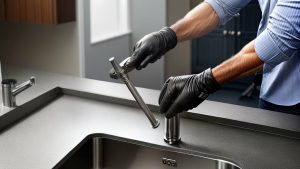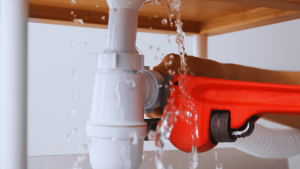Dealing with a kitchen sink that won’t drain or a leaky faucet can be a real headache. However, before you call a plumbing professional, you can save time and money by trying simple DIY repairs.
In this section, we will provide you with a step-by-step guide on how to fix the plumbing for a kitchen sink. We’ve got you covered whether you’re dealing with a clogged drain or a faulty pipe. Following our easy DIY guide, you can handle common sink issues without breaking the bank.
Key Takeaways:
- You can diagnose the problem more quickly and accurately by identifying common sink issues.
- Having the right tools and materials on hand before starting repairs is crucial.

Identifying Common Kitchen Sink Plumbing Problems
Before we can tackle any repairs, it’s essential to identify the source of the problem. Here are some common kitchen sink plumbing problems you may encounter:
| Problem | Cause | Solution |
|---|---|---|
| Leaky Faucet | Worn out O-ring or washer | Replace the faulty part or entire faucet |
| Clogged Drain | Accumulated food particles or debris | Use a plunger, snake, or chemical drain cleaner to remove the blockage |
| Low Water Pressure | Mineral buildup or faulty aerator | Clean or replace the aerator or address the mineral buildup in pipes |
You may also encounter leaky pipes, garbage disposal malfunction, and improper installation. Understanding the source of the problem will help you decide on the appropriate repair action.
Tools and Materials Needed for DIY Kitchen Sink Plumbing Repair
Before starting any repair work, it’s essential to have the necessary tools and materials on hand. Here is a list of items you’ll need:
| Tools | Materials |
|---|---|
| Adjustable wrench | Plumber’s putty or silicone caulk |
| Channel-lock pliers | Teflon tape |
| Basin wrench | Pipe joint compound |
| Hacksaw | PVC or copper pipes (depending on the plumbing system) |
| Screwdrivers (flathead and Phillips) | Plumbing fittings (elbows, tees, couplings, etc.) |
| Plumber’s snake | Replacement sink parts (if necessary) |
Remember that the tools and materials required for your repair could differ based on the specific issue you’re addressing. Assess the problem and research what you need before starting any work.
Pro Tip: Wear gloves and protective eyewear when handling plumbing materials.
Step-by-Step Guide for Kitchen Sink Plumbing Repair
Now that you have identified the problem and gathered the necessary tools and materials, it’s time to start the repair process. Adhere to these steps meticulously to guarantee a successful do-it-yourself kitchen sink plumbing repair:
- Shut off the water supply to the sink. This can be done by turning the valve under the sink clockwise.
- Position a bucket or towel under the P-trap to capture any water or debris that might spill out as you proceed with the repair.
- Utilize a wrench or pliers to loosen the nuts securing the P-trap in its position. Carefully remove the P-trap and set it aside.
- Use a plumber’s snake or wire coat hanger to clear any debris or clogs in the drainpipe. Insert the snake or hanger into the pipe and twist it back and forth until the clog is removed.
- If the problem is a leaky faucet, use a screwdriver to remove the faucet handle. Replace the O-ring and washer inside the faucet assembly. Reassemble the faucet handle and turn the water supply back on to test for leaks.
- If the problem is a faulty pipe or fixture, use a wrench or pliers to remove the damaged component. Replace it with a new part and tighten the nuts or bolts securely.
- Reattach the P-trap and tighten the nuts securely. Turn the water supply back on and test for leaks.
Congratulations! You have completed the repair process for your kitchen sink plumbing. Always prioritize safety and seek professional assistance if you encounter any challenges during the repair procedure.
Tips for Proper Kitchen Sink Plumbing Installation
Now that you have successfully repaired your kitchen sink plumbing, it’s essential to install it properly to prevent future issues. Here are some tips to ensure a smooth installation:
- Before installation, ensure you have all the necessary tools and materials.
- Position the sink and mark where the drain and water lines go.
- Ensure proper alignment between the sink, drain, and water lines.
- Use the appropriate fittings and connectors for the pipes you use.
- Securely tighten all connections, but avoid over-tightening, as this could damage the pipes.
- Test the installation by running water through the sink and checking for leaks.
- If you encounter any difficulties during installation, consult the manufacturer’s instructions or seek professional guidance.
By following these tips, you can confidently install your kitchen sink plumbing and avoid future plumbing problems.
Essential Kitchen Sink Plumbing Maintenance Tips
Properly maintaining your kitchen sink plumbing system is imperative for its durability and optimal functionality. Here are some essential maintenance tips:
- Clean your sink frequently: Regular cleaning of the sink and drain will prevent grime buildup and minimize the risk of clogging.
- Check for leaks: Periodically inspect the pipes and connections under your sink for signs of leaks. Identifying and rectifying issues early on can help prevent expensive damage in the future.
- Avoid chemical drain cleaners: Although they seem appealing, these products can potentially harm your pipes and trigger significant plumbing issues. Opting for natural alternatives such as baking soda and vinegar is better.
- Address minor issues promptly: Don’t let small plumbing problems grow into larger ones. If you notice a slow drain or weak water pressure, take action before it becomes a significant issue.
- Be mindful of what goes down the drain: Steer clear of pouring grease, oil, or food scraps down the sink, as they can lead to clogs and harm your pipes. Use a strainer to catch any solid debris and dispose of them properly.
By adhering to these crucial maintenance tips, you can uphold the efficient operation of your kitchen sink plumbing system and evade the need for expensive repairs.
Troubleshooting Kitchen Sink Plumbing Problems
If you’re still experiencing issues after attempting to fix the plumbing for your kitchen sink, don’t worry. We’ve compiled a list of common problems and their possible solutions to help guide you through the troubleshooting process.
Your sink is draining slowly: This could be caused by a clog in the drain or pipes. Consider utilizing a plunger or a drain snake to dislodge and clear any obstructions. If the problem persists, the issue may be further down the line and require professional assistance.
Your sink is leaking: The most common cause of a leaky sink is a faulty seal or gasket. Inspect the pipes and connections for any indications of wear or damage, and replace them as required.
Your sink emits foul odors: This could signify a buildup of food particles or grease in the pipes. Try using a drain cleaner or a combination of vinegar and baking soda to clean out the pipes. Regularly cleaning your sink and disposal can also help prevent this issue.
If these troubleshooting methods do not solve the problem, it may be time to consult a professional plumber. Professionals in the field have the expertise to identify the issue and guide you toward the best course of action, which can ultimately lead to long-term time and cost savings.
Common Mistakes to Avoid When Fixing Kitchen Sink Plumbing
Fixing kitchen sink plumbing issues can be challenging, especially if you’re unfamiliar with plumbing systems. To help you avoid common mistakes and ensure a successful repair, we’ve listed some things to keep in mind:
- I am not turning off the water supply. Before you start repairing any plumbing issue, make sure to turn off the water supply. Please do so to avoid a flood and extensive water damage.
- You need to be using the correct tools and materials. Using the wrong type of wrench or sealant can lead to further damage or leaks. It’s essential to utilize the tools and materials specified in the manufacturer’s instructions or seek guidance from a professional for proper usage.
- Over-tightening pipes and fixtures. Over-tightening pipes and fixtures can cause them to crack or break. Use a gentle hand to tighten them just enough to stop any leaks.
- You are ignoring safety precautions. Engaging with plumbing systems can pose risks without adhering to proper safety measures. Be sure to don protective gear such as gloves and goggles, and if necessary, deactivate the electricity supply as a precaution.
- They are not seeking professional help when needed. Some plumbing issues may require professional expertise or equipment. If you need help with a repair, feel free to seek help from a licensed plumber or expert.
By being aware of these common mistakes, you can avoid causing further damage and ensure a successful DIY kitchen sink plumbing repair. Always prioritize safety and follow recommended procedures, and you’ll be well on your way to a properly functioning plumbing system.
Additional Resources for Kitchen Sink Plumbing Repair
Sometimes, you may encounter plumbing issues requiring extra assistance and guidance. Fortunately, abundant resources are accessible to assist you in resolving your kitchen sink plumbing concerns.
Online Tutorials and Guides
Many online tutorials and guides are available, encompassing instructional videos, step-by-step manuals, and informative articles to offer further assistance and insights. Some popular options include Youtube tutorials, DIY plumbing blogs, and home improvement websites like This Old House and Family Handyman.
Manufacturer’s Manuals
Consulting the manufacturer’s manual can be beneficial if you’re experiencing issues with specific fixtures or appliances. Most manufacturers provide detailed instructions and troubleshooting tips for their products, making diagnosing and repairing issues easier.
Professional Assistance
If you’re unsure of your plumbing skills or encounter a problem you can’t solve, it’s best to seek professional help. Local plumbing companies and individual contractors can offer their expertise and assistance to fix any issues with your kitchen sink plumbing.
By utilizing these resources, you can successfully repair your kitchen sink plumbing and ensure the longevity of your plumbing system.
Conclusion
Fixing the plumbing for a kitchen sink may seem daunting at first, but with our easy DIY guide and troubleshooting tips, you can handle common issues confidently. Always prioritize safety, gather the necessary tools and materials before starting, and take proper maintenance measures to prevent future problems. Mastering how to fix the plumbing for a kitchen sink can be invaluable knowledge, and once you’ve tackled that, you might also find it helpful to learn how to remove a kitchen sink efficiently.
By following our step-by-step guide and avoiding common repair mistakes, you can save time and money by fixing the plumbing yourself. However, if you are unsure about any repair aspect or encounter a complex issue, consult professional help.
Our article has been informative and helpful in guiding you through fixing the kitchen sink plumbing. Feel free to browse our additional resources and references for more information or visual guides to aid your repair journey.
FAQ
Q: How can I identify common kitchen sink plumbing problems?
A: Common kitchen sink plumbing problems include leaky faucets, clogged drains, and low water pressure. To identify these issues, look for signs such as dripping water, slow drainage, or unusual noises.
Q: What tools and materials do I need for DIY kitchen sink plumbing repair?
A: You will need tools like wrenches and pliers, plumbing sealants, replacement parts, and pipe fittings. Refer to our comprehensive list of tools and materials needed for a complete guide.
Q: Can you provide a step-by-step guide for kitchen sink plumbing repair?
A: Certainly! Our comprehensive step-by-step guide will meticulously guide you through repairing your kitchen sink plumbing. From shutting off the water supply to replacing faulty pipes or fixtures, we provide detailed instructions for a successful repair.
Q: What are some tips for proper kitchen sink plumbing installation?
A: Proper installation is crucial for a leak-free plumbing system. Ensure proper alignment, use the right fittings and connectors, and follow our best practices guide for a successful kitchen sink plumbing installation.
Q: How can I maintain my kitchen sink plumbing?
A: Regular cleaning, checking for leaks, and addressing minor issues promptly are essential for maintaining your kitchen sink plumbing. Follow our maintenance tips to keep your plumbing in optimal condition.
Q: What troubleshooting tips do you have for kitchen sink plumbing problems?
A: If you encounter issues like slow drains or water pressure problems, our troubleshooting tips will help you identify and solve these problems effectively. Follow our step-by-step guide to resolve common kitchen sink plumbing issues.
Q: What common mistakes should I avoid when fixing kitchen sink plumbing?
A: While DIY repairs can save you money, there are common mistakes to avoid. We highlight these mistakes and provide tips on how to avoid them, ensuring a successful plumbing repair.
Q: Are there any additional resources for kitchen sink plumbing repair?
A: Yes! Our additional resources section provides references and links to visual guides, online tutorials, and professional assistance for kitchen sink plumbing repair. These resources will further enhance your skills and understanding.

It’s me, Amber Hayden, the heart and soul behind SagarmathaOnlineMedia.com. From a young age, I’ve been head over heels for everything home-related, from interior decor to gardening. I’m the type who can’t resist a well-crafted piece of furniture, and I firmly believe that a home isn’t complete without a pet or two. But it’s not just about creating pretty spaces for me. I’m all about making homes that tell a story reflecting the people living there. SagarmathaOnlineMedia.com is my way of sharing this passion with you. Whether you’re looking for tips to jazz up your living room, advice on pet care, or ideas to make your garden bloom, I’m here to help. So, let’s embark on this journey together and make your house a home!



